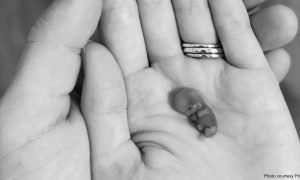Diagnosed with ovarian cancer during pregnancy, a mother in the UK underwent a remarkable surgery in which her uterus was temporarily removed from her body — with her baby inside — and replaced after doctors removed the cancer.
Key Takeaways:
- Lucy Isaac was diagnosed with ovarian cancer at 12 weeks pregnant.
- She was too far along for standard keyhole surgery, but doctors knew they couldn’t wait for the baby to be born, which would allow the cancer time to spread.
- Doctors performed a rare surgery in which her uterus was removed with her baby inside, so the cancer could be taken out. Then her uterus was placed back in her body.
- Baby Rafferty was born 17 weeks later, healthy, and Lucy continues to do well.
The Details:
According to Oxford University Hospital, Lucy Isaac was diagnosed with ovarian cancer at 12 weeks pregnant following a routine ultrasound. She was too far along in pregnancy for the standard keyhole surgery, and doctors knew that waiting until the baby was born could allow the cancer to spread.
They came up with a plan to protect both patients.
To protect her preborn baby and save Lucy, doctors proposed a groundbreaking surgery. They would lift Lucy’s uterus out of her body with baby Rafferty still inside, allowing them to access the tumor and remove it. Then they would place the uterus back inside Lucy’s body to give baby Rafferty time to continue to grow.
Hooman Soleymani Majd was the doctor who first proposed the surgery, which would take five hours and involve 15 medical professionals. Lucy’s uterus remained connected to the uterine artery, keeping blood and oxygen flowing to Rafferty. It also remained attached to the fallopian tube and cervix.
During the surgery, two team members held her uterus for two hours with Rafferty inside, monitoring his heart rate and temperature. The uterus was wrapped in a warm, sterile saline pack, which was replaced every 20 minutes, to mimic being inside Lucy’s body .
During the surgery, a slice of the tumor was taken for examination and found to be stage two. The cancer had spread to the surrounding tissue, making the surgery more complex. But after the cancer was removed, the uterus was put back in place, and Lucy’s abdomen was stitched closed.
“I am pleased with the success of the procedure. It was a complex and challenging operation, but the dedication and expertise of our multidisciplinary team ensured a positive outcome for both Lucy and her baby,” said Majd.
Rafferty was ultimately born healthy at 37 weeks.
Lucy’s husband, Adam, had previously undergone a kidney transplant before the couple was able to conceive a child. He explained, “To finally hold Rafferty in our arms after everything we have been through was the most amazing moment. The care Lucy received at OUH has been incredible. I am grateful to everyone involved for saving my wife and baby.”
Majd said meeting Rafferty two weeks after his birth was “immensely emotional” for him and the rest of the surgical team. “This achievement not only highlights the advancements in medical science but also reinforces our commitment to providing innovative and life-saving procedures. I am grateful for the trust placed in us, and proud of the collaborative effort that made this possible.”
The Bottom Line:
Induced abortion — the direct and intentional killing of a preborn child — is not necessary even when a woman’s health is at risk. Depending on the exact diagnosis, other options are available to protect and save both mother and child, as the Isaac family’s story demonstrates.
If a child must be delivered early, he or she does not have to be actively killed by abortion first. Preterm delivery during medical emergencies is not an abortion and is not prohibited by any law.
Follow Live Action News on Facebook and Instagram for more pro-life news.







